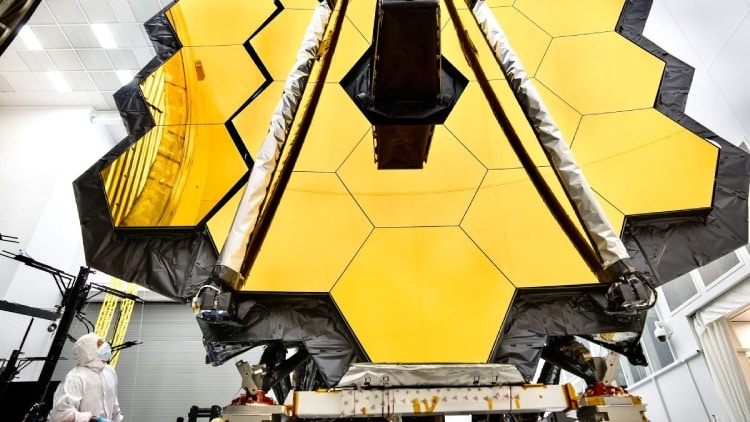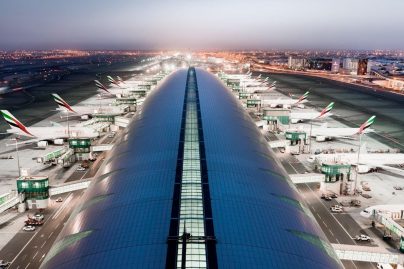NASA’s James Webb Space Telescope is all set for lift off
Fri 24 Dec 2021
The James Webb Space Telescope is finally on the launchpad. The space observatory, safely tucked inside an Ariane 5 rocket, is expected to launch on December 25.
The rollout took about two hours to complete, according to NASA.
Arianespace’s Ariane 5 rocket, with NASA’s James Webb Space Telescope on board, was rolled out to the launchpad in French Guiana.
“With Webb and its rocket securely on the pad, the team will run electrical diagnostics to ensure all lights are green for launch. Teams will power on the observatory while at the launch pad to run one final aliveness test to ensure all systems have power and are working before liftoff,” according to an update from NASA.
The launch window opens Christmas morning with live coverage of the launch will stream on NASA’s TV channel and website.
The highly anticipated launch of the James Webb Space Telescope has been delayed multiple times.
Another weather forecast reviewed confirmed the new launch date of December 25.
Heralded to be the premier space observatory of the next decade, the telescope, initially planned for a 2018 launch, has endured years of delays, including a combination of factors brought on by the pandemic and technical challenges.
Last week, teams were working on “a communication issue between the observatory and the launch vehicle system” that pushed the launch to December 24, NASA shared in an online post. The agency has since stated that the problem has been mostly resolved and would not prevent the launch.
The previous launch date of December 18 was pushed to December 22 after an incident occurred during launch preparations in November.
As technicians were preparing to attach the telescope to the upper stage of the Ariane 5 rocket that will be used during the launch, “a sudden, unplanned release of a clamp band caused a vibration throughout the observatory,” according to the agency.
After testing and reviewing the observatory, teams concluded that the telescope was not damaged, and fueling was completed on December 3. The telescope was placed on top of the rocket on December 11.
What the telescope will do
Considered to be the world’s most powerful complex space observatory, Webb will answer questions about our solar system, study exoplanets in new ways and look deeper into the universe than we’ve ever been able to. Webb will peer into the very atmospheres of exoplanets, some of which are potentially habitable, and could uncover clues in the ongoing search for life outside of Earth.
The telescope comes equipped with a mirror that can extend 21 feet and 4 inches (6.5 metres) — a massive length that will allow the mirror to collect more light from the objects it observes once the telescope is in space. The more light the mirror can collect, the more details the telescope can observe.
The mirror includes 18 hexagonal gold-coated segments, every 4.3 feet (1.32 metres) in diameter.
It’s the largest mirror NASA has ever built, the agency said, but its size created a unique problem. The mirror was so large that it couldn’t fit inside a rocket. So NASA teams designed the telescope as a series of moving parts that can fold origami-style and fit inside a 16-foot (5-metres) space for launch.
Webb will act as an infrared sleuth, detecting light that is invisible to us and revealing otherwise hidden regions of space, according to NASA.
The concept for the telescope was first imagined as a successor to Hubble at a workshop in 1989, and construction on Webb first began in 2004. Since then, thousands of scientists, technicians and engineers from 14 countries have spent 40 million hours building the telescope.
Now, Webb could help researchers understand the origins of the universe and begin to answer key questions about our existence, such as where we came from and if we’re alone in the cosmos.
Once the telescope launches, it will travel for about a month until it reaches an orbit about 1.6 million kilometres away from Earth. Over 29 days, Webb will unfold its mirrors and unfurl a protective sun shield. This process involves thousands of parts that must work perfectly in the right sequence.
Fortunately, each step can be controlled from the ground in case there are issues.
Then Webb will go through a period of setting up shop in space that lasts for six months, which involves cooling down the instruments, alignment and calibration. All of the instruments will go through a checkout process to see how they are functioning.
Then, it will begin to collect data and its first images later in 2022. Thousands of scientists have been waiting for years to see what Webb can show us.
Source: Agencies

 Apr 16 2024
Apr 16 2024











